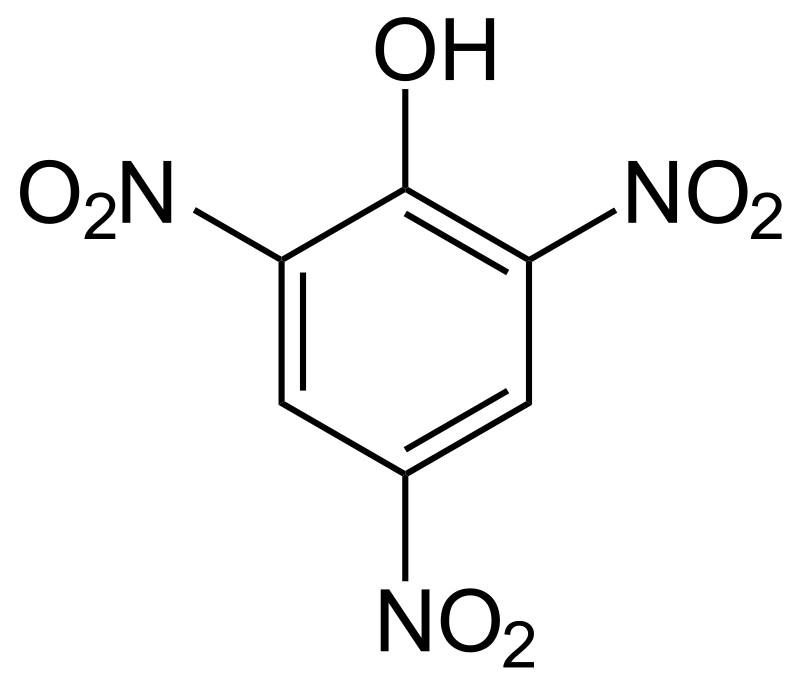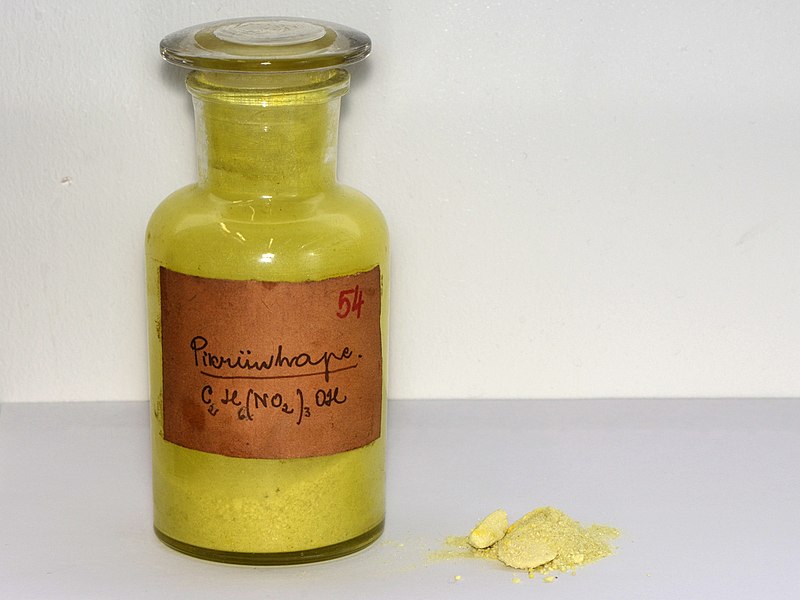What is the Difference Between Picric Acid and Benzoic Acid
The key difference between picric acid and benzoic acid is that picric acid is available as a yellow color powder form, whereas benzoic acid is available as a crystalline solid that is colorless.
Picric acid and benzoic acid are important organic compounds in organic synthesis reactions. These substances form aqueous solutions having a pH that is below 7.0.
CONTENTS
1. Overview and Key Difference
2. What is Picric Acid
3. What is Benzoic Acid
4. Picric Acid vs Benzoic Acid in Tabular Form
5. Summary – Picric Acid vs Benzoic Acid
What is Picric Acid?
Picric acid is an organic compound having the chemical formula (O2N)3C6H2OH. The IUPAC name of this compound is 2,4,6-trinitrophenol. It has a bitter taste, which leads to its name “picric,” which refers to the “bitter taste” in the Greek language. Picric acid is among the most acidic phenols. Similar to other nitrated organic compounds, picric acid is also explosive, which defines its major application. However, it has some uses in medicine as well; as an antiseptic, to treat burn wounds, and as a dye.

Figure 01: The Chemical Structure of Picric Acid
Usually, the ring structure of the phenol molecule is highly active. It is activated towards electrophilic substitution reactions. Therefore, when we attempt for nitration of phenol, even using dilute nitric acid, it gives high molecular weight tars. Thereafter, we need to nitrate it with concentrated nitric acid. There, the nitro groups tend to replace sulfonic acid groups. This reaction is highly exothermic. Therefore, we need to carefully control the temperature of the reaction mixture. This is a common method of producing picric acid. Alternatively, we can produce this substance from the nitration of 2,4-dinitrophenol using nitric acid.

Figure 02: Appearance of Picric Acid
There are several uses of picric acid, including its use in munitions and explosives, in the preparation of crystalline salts of organic bases, in the production of some alloys, in the production of Bouin solution, etc.
What is Benzoic Acid?
Benzoic acid is the simplest aromatic carboxylic acid. The molecular formula of benzoic acid is C6H5COOH. The molar mass of benzoic acid is about 122.12 g/mol. One benzoic acid molecule is composed of a benzene ring substituted with a carboxylic acid group (-COOH).

Figure 03: The Chemical Structure of Benzoic Acid
At room temperature and pressure, benzoic acid is a white crystalline solid. It is slightly soluble in water. Benzoic acid has a pleasant odor. The melting point of benzoic acid solid is about 122.41 °C. The boiling point of benzoic acid is given as 249.2 °C, but it decomposes at 370 °C.
Benzoic acid can undergo electrophilic aromatic substitution due to the electron-withdrawing property of the carboxylic group. The carboxylic acid can provide the aromatic ring with pi electrons. Then it becomes rich in electrons. Therefore, electrophiles can react with the aromatic ring.
What is the Difference Between Picric Acid and Benzoic Acid?
Picric acid and benzoic acid are important organic compounds in organic synthesis reactions. These substances form aqueous solutions having a pH that is below 7.0. The key difference between picric acid and benzoic acid is that picric acid is available as a yellow color powder form, whereas benzoic acid is available as a crystalline solid that is colorless. Moreover, picric acid is odorless, while benzoic acid has a faint, pleasant odor.
The below infographic presents the differences between picric acid and benzoic acid in tabular form for side by side comparison.
Summary – Picric Acid vs Benzoic Acid
Picric acid is an organic compound having the chemical formula (O2N)3C6H2OH. Benzoic acid is the simplest aromatic carboxylic acid. The key difference between picric acid and benzoic acid is that picric acid is available as a yellow color powder form, whereas benzoic acid is available as a crystalline solid that is colorless.
Reference:
1. “Picric Acid.” Encyclopædia Britannica, Encyclopædia Britannica, Inc.
Image Courtesy:
1. “Pikrinsäure” By NEUROtiker – Own work (Public Domain) via Commons Wikimedia
2. “Pikriinhape54” By Tiirats – Own work (CC BY-SA 3.0) via Commons Wikimedia
3. “Benzoesäure” By NEUROtiker – Own work (Public Domain) via Commons Wikimedia
ncG1vNJzZmivp6x7pbXFn5yrnZ6YsqOx07CcnqZemLyue9ahmK1lmah6tbTEZpuinpaav6a6wp5km52krLKmuoypoJyqmZh6oq%2FInWSappRir6a62aignGWRmLalew%3D%3D